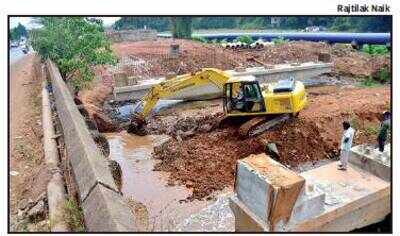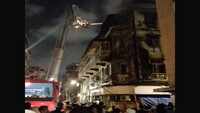
PANAJI: Huge embankments created for a six-lane highway, partly burying the Mapusa river on the town’s southern boundary, as well as the reclamation of more low-lying paddy fields for a downtown scheme, are recipes of imminent flooding, civil society fears.
The reclamation is for a scheme which envisages the creation of a commercial hub and other amenities and facilities around an interstate bus stand, market, parking facility and Ravindra Bhavan on 18 lakh sq m of agricultural land. This is in addition to largescale land-filling in Guirim and Bastora for expansion of NH 66.
Between the Mapusa market and the river, more land in the mangrove belt has been carved out as piecemeal development continues. The area covers the drainage system of Mapusa town. During monsoon, rain water from the hill in the north flows into low-lying khazan land, criss-crossed by rivulets from Parra, Khorlim and Socorro, supporting vast tracts of agricultural land. A major part of the town lies on higher ground, but commercial areas and settlements are sprawled below as well.
“The future of the Mapusa market area depends on the health and integrity of a small creek terminating behind the market, but the land beyond it, up to the thick mangrove belt, is being thoughtlessly reclaimed,” said environmentalist Nandkumar Kamat.
Tulio de Souza, architect and president of Guirim comunidade, agrees. “The reckless destruction of fields and vegetation bordering the Mapusa river, which is also encroached upon in three places, is likely to be disastrous. The river serves to carry the overflow from the town’s catchment,” he said.
The recent burst of reclamation activity on NH 66 — after massive flooding in several villages in June 2018 — has raised concerns. “We are not against development, but it cannot be at the cost of rivers. The shrunken catchment area has to be protected,” said Bastora sarpanch Savio Martins.
Town and country planning department officials say that much-needed facilities can be planned while the drainage could be “systemised”. But others reject this argument, stating that a natural eco-system has been largely destroyed.
“Nearby villages and Mapusa town will inevitably suffer devastating effects of this ill-conceived plan,” de Souza said.
“It makes perfect sense to protect the existing natural rivulets due to the rise in sea level and storm surges,” Kamat said.
The reclamation is for a scheme which envisages the creation of a commercial hub and other amenities and facilities around an interstate bus stand, market, parking facility and Ravindra Bhavan on 18 lakh sq m of agricultural land. This is in addition to largescale land-filling in Guirim and Bastora for expansion of NH 66.
Between the Mapusa market and the river, more land in the mangrove belt has been carved out as piecemeal development continues. The area covers the drainage system of Mapusa town. During monsoon, rain water from the hill in the north flows into low-lying khazan land, criss-crossed by rivulets from Parra, Khorlim and Socorro, supporting vast tracts of agricultural land. A major part of the town lies on higher ground, but commercial areas and settlements are sprawled below as well.
“The future of the Mapusa market area depends on the health and integrity of a small creek terminating behind the market, but the land beyond it, up to the thick mangrove belt, is being thoughtlessly reclaimed,” said environmentalist Nandkumar Kamat.
Tulio de Souza, architect and president of Guirim comunidade, agrees. “The reckless destruction of fields and vegetation bordering the Mapusa river, which is also encroached upon in three places, is likely to be disastrous. The river serves to carry the overflow from the town’s catchment,” he said.
The recent burst of reclamation activity on NH 66 — after massive flooding in several villages in June 2018 — has raised concerns. “We are not against development, but it cannot be at the cost of rivers. The shrunken catchment area has to be protected,” said Bastora sarpanch Savio Martins.
Town and country planning department officials say that much-needed facilities can be planned while the drainage could be “systemised”. But others reject this argument, stating that a natural eco-system has been largely destroyed.
“Nearby villages and Mapusa town will inevitably suffer devastating effects of this ill-conceived plan,” de Souza said.
“It makes perfect sense to protect the existing natural rivulets due to the rise in sea level and storm surges,” Kamat said.
LOK SABHA ELECTION RESULT 2019
AP election results 2019Telangana elections results 2019Odisha election results 2019Chhattisgarh election results 2019Punjab election results 2019Uttarakhand election results 2019Karnataka election results 2019Madhya Pradesh election results 2019Himachal Pradesh election results 2019Haryana election results 2019Delhi election results 2019Maharashtra election results 2019Kerala election results 2019Bihar election results 2019Gujarat Lok Sabha election results 2019UP Lok Sabha election results 2019West Bengal election results 2019Tamil Nadu election results 2019
#ElectionsWithTimes
Quick Links
Lok Sabha Election Schedule 2019Lok Sabha Election NewsDelhi Capitals teamMI team 2019Rajasthan Royals 2019RCB team 2019Maharashtra Lok Sabha ConstituenciesBJP Candidate ListBJP List 2019 TamilnaduShiv Sena List 2019AP BJP List 2019Mamata BanerjeeBJP List 2019 MaharashtraPriyanka GandhiBJP List 2019 KarnatakaAMMK Candidate List 2019BJP List 2019 WBLok Sabha Elections in Tamil NaduBSP List 2019 UPNews in TamilLok Sabha Poll 2019Satta Matka 2018PM ModiMahagathbandhanNagpur BJP Candidate ListChandrababu NaiduTamil Nadu ElectionsUrmila MatondkarNews in TeluguMadras High CourtTejashwi YadavArvind KejriwalTejasvi SuryaPawan KalyanArvind KejriwalYogi AdityanathJaya PradaSatta King 2019Srinagar encounter
Get the app









